
Last Updated On September 20th, 2022
Top 10 Reviews
Telescopes have progressed drastically since they were first created in the Netherlands in 1608. They are no longer reserved for scientists and astronomers. But are now also accessible to everyone who’s willing to invest their time in learning a few things and to have some fun, too.
Our telescope reviews aim to make this process a bit easier so you can get to the fun part – observing terrestrial and celestial objects, as quickly as possible. The language of telescopes is highly scientific and it’s likely astronomy uses terms you aren’t familiar with. That’s why we paired our top 10 list with a buyer’s guide to explain some of the finer details associated with choosing the best telescope for you. Whether you are looking for your first telescope or for something more advanced, we included options we think you’ll love.
The Celestron Travel Scope is our Editor’s Choice for the best refractor telescope. Celestron is a popular, highly-rated brand so it’s no surprise they made the top of our list. Their Travel Scope produces superb-quality images and is designed for easy portability.
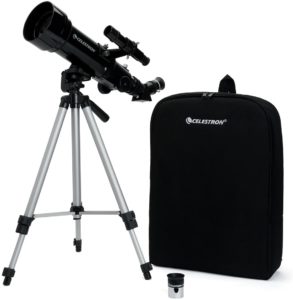
The Celestron Travel telescope features a 70mm aperture and comes with 10mm and 20mm eyepieces included, achieving either 20x or 40x magnification. Its highest theoretical magnification reaches 165x, its focal length is 400mm, and has a focal ratio of f/5.71. A 5×24 finder scope attaches to the side of the main scope. Plus, a top-rated astronomy software is also included to help you locate and view specific objects in the galaxy.
The entire set weighs only about 1.2kg and it comes with a convenient backpack-style carrying bag for easy transport, making it perfect for hikes or camping. What’s more, it is super easy to set up and doesn’t require any tools. A full-size alt-az mount is also provided in this telescope set. It is impressively lightweight, made from aluminium, and has a clutch lever for precise, smooth adjustment. The Travel Scope comes with a two-year warranty, too.
While the tripod is lightweight, it is a bit flimsy and less stable, but that is to be expected with a travel mount. The Travel Scope does have some plastic parts, decreasing durability. And, it doesn’t come with the best eyepiece but that can easily be replaced.

The Celestron PowerSeeker 70AZ refractor telescope is next on the best telescopes list. The Power Seeker has quality optics that are great for viewing the night sky, the moon, and planets.
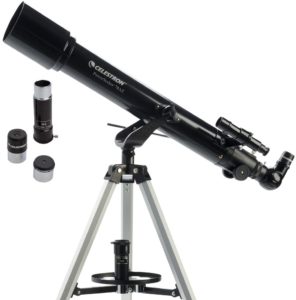
Celestron’s PowerSeeker telescope features a 70mm aperture and a 700mm focal length. It comes with a Barlow lens, a 20mm and a 4mm eyepieces for 35x and 175x magnified viewing. A 5×24 finderscope is attached to the side of the main scope and an alt-azimuth aluminium tripod mount with a convenient accessory tray is also included.
As with other Celestron telescopes, a free Sky Portal app download can guide you across the sky to find faint objects. In addition, TheSkyX – First Light Edition software for astronomy can also be used on your home computer to access Celestron’s database of 10,000 celestial bodies, 75 enhanced images of solar system bodies, and printable sky maps. The software is useful in case you plan to travel to a remote area that’s out of cell service. The PowerSeeker also features a no-tool setup so its basically ready to go straight out of the box. Plus, it offers a two-year warranty.
Unfortunately, the PowerSeeker telescope’s lenses and mount leave something to be desired and it has some plastic parts included in the design. However, the high-quality images it produces make up for this and you can always upgrade parts on consumer telescopes.

The Emarth refractor telescope makes our list of the best telescopes for its ease of use and super lightweight design that weighs only 1.3 kgs.
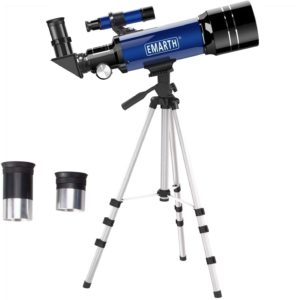
Emarth refractor telescopes have a 70mm aperture size, a 360mm focal length, and an f/5.1 focal ratio denoting its wide field of view. This telescope comes with a 25 mm and a 10mm eyepiece lens that allows 51x to 128x magnification. A 5x24v finder scope is attached to the side of the main scope tube to help you locate planets, stars, and moons more easily.
Emarth telescopes have an easy no-tool setup which is great if you plan on travelling with your device. An adjustable aluminium tripod mount is also included with antiskid feet, to minimise the risk of sliding or slipping during mount adjustments. The entire set fits into a backpack style carrying case for easy portability.
The Emarth telescope does not come with a Barlow lens or a warranty and you can expect some wobble from the lightweight tripod mount. Also, it is not recommended for astrophotography but makes an excellent choice for beginner astronomers who want simple sky viewing, day or night.

The AOMEKIE is the best telescope for beginners on our list. We chose this is as the best amateur telescope for its ease of use and the moon filter accessory it comes with. The AOMEKIE would also make a good choice for kids looking for an instrument, not just a toy.
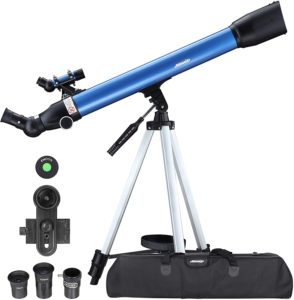
AOMEKIE telescopes have a 70mm aperture and come with a K25mm and K6mm eyepiece, a 3x Barlow lens, and a metal moon filter. The moon naturally reflects a lot of light making it harder for a telescope to pick up craters and other details. A moon filter will help cut back on light pollution and provides a clearer, more detailed image.
This telescope features an erecting eyepiece for easier viewing, a 5×24 finder scope located on the side, and a convenient phone adapter that allows you to take videos and pictures. The phone adapter also helps with searching for celestial bodies and can act as a finder. This telescope set weighs only 2.07kg, including the lightweight aluminium alt-az tripod with retractable legs. No tools are required for setup.
The AOMEKIE is not the best choice for an experienced astronomer or hobbyist. It does not come with a warranty, has a flimsy tripod and a shaky phone adapter which makes it hard to hit buttons on your phone without making the image wobble or lose focus momentarily.

The Slokey SkyWays 40070 is our top choice for the best telescope with a phone holder. It also makes a great option for kids or an amateur astronomer.
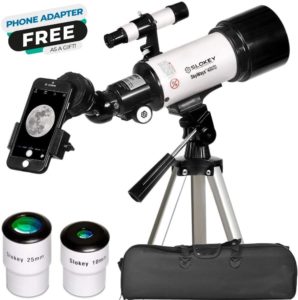
The SkyWays 40070 features a 70mm aperture with a 400mm focal length. It comes with a 3x Barlow lens, a 10mm and a 25mm eyepieces included. This combination of lenses allows you to achieve 16x, 40x, 48x, and 120x magnification for viewing objects in the sky. This entry-level model also comes with a carry bag for easy transport and a two-year warranty to back its durability.
This Slokey telescope has a phone adapter that helps you to locate celestial bodies, eliminating the need to do so manually. Moreover, it has a red dot finder scope for the manual location of heavenly bodies. The SkyWays set likewise comes with a lightweight and fully adjustable alt-azimuth tripod that has a height range of 49cm to 132cm. The lower height option is a viable reason why it’s considered as one of the best telescopes for kids.
The SkyWays telescope comes with lower quality lenses and the tripod can wobble due to its lightweight design. However, both can easily be upgraded if you want to venture beyond the realm of amateur astronomy. Additionally, we do not recommend this telescope for more than amateur astronomy.

The Celestron NexStar 5 SE is our top Luxury Choice for the best astronomical telescope. We love the high-quality images it produces, the built-in computerised finder, and its iconic orange tube.
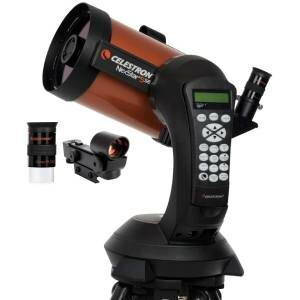
The Celestron NexStar 5 SE makes finding celestial objects easy and fun with its intuitive computerised finder. It can provide a tour of the night sky for you, using its 40,000 celestial object database which includes the Orion nebula, the moon, planets, and other solar system objects. It highlights the best viewable objects based on your location and also has a red dot finderscope.
This Schmidt-Cassegrain compound telescope features a 5-inch aperture, a 25mm eyepiece, an f/10 focal ratio, and its highest theoretical magnification is 295x. The sturdy steel tripod has an updated single fork arm design that is compact and works best placed on a steady surface. The entire Celestron NexStar set up can be disassembled for easier transport and weighs 28 lbs in total.
The Celestron NexStar 5 SE has a shorter battery life, so we recommend buying a power cable to accompany your setup. The included computer software may be pretty outdated, but Celestron allows a free download of their Sky Portal app which is far superior. There are also some reports of the mount wobbling due to its single leg design.

The Bresser Classic telescope features a refractor optical design. Both compact and lightweight, we also love the wide viewing area established by the lower focal length.
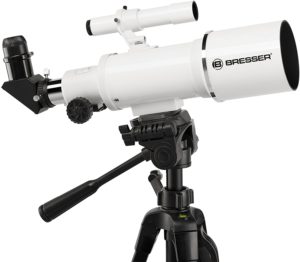
The Bresser Classic telescope features a 70mm aperture, with three eyepieces for sky viewing – 4mm, 12.5mm, and 20mm. It has an 18x-140x potential magnification and a 350mm focal length that enables a wide viewing area to be accessed through the tube. The 5×24 viewfinder has a hair cross design for easy and specific targeting. An erecting prism is also incorporated into the refractor design to create an upright, correct image for observation.
Each Bresser telescope comes with an aluminium tripod mount with a fully adjustable height and smooth, slow-motion transition. Bresser also includes a phone holder with suction cups for convenient viewing of videos and pictures. The Classic telescope can easily be transported using its carrying bag. It weighs 1.15kg and has a convenient and quick no-tool setup process.
The Bresser Classic tripod may come with three eyepieces instead of just one or two but they aren’t top of the line when it comes to quality. You should also be aware that this telescope doesn’t come with a warranty and the tripod may likewise wobble due to its lightweight design.

The Orion telescope is next on our best telescopes list. We love its Maksutov-Cassegrain optical design that comes in a compact and portable tabletop design.
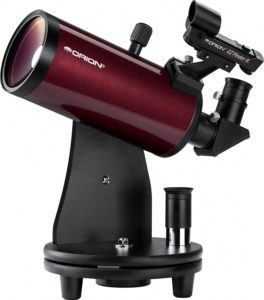
The Orion StarMax has a large aperture of 90mm and comes with 10mm and 25mm eyepieces that enable 50x and 125x magnification. The EZ Finder II scope is paired with a red dot viewfinder on the objective lens to make finding specific celestial bodies easier and faster for amateur astronomers. It also features a 1250mm focal length on its telescope tube and an f/13.8 focal ratio.
This Maksutov-Cassegrain telescope comes with a sturdy table top mount that swivels for smooth adjustment. The mount can also be connected. Combined, the telescope and mount weigh 6.5 lbs in total.
The Orion StarMax does not come with a tripod so it requires a table or a robust and tall support for sky viewing. Also, consumers report the focus being tricky at high magnification and may get poor image quality when attempting to view deep sky objects like rings on planets.

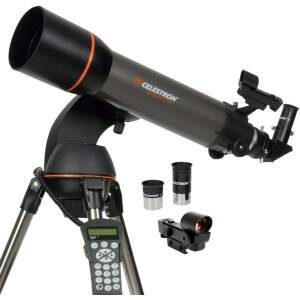
This Celestron Nexstar 102SLT telescope comes with a 102mm aperture with a 660mm focal length. It comes with a 9mm and 25mm eyepiece, a Star Pointer finderscope, and a stainless steel tripod with a convenient built-in accessory tray. It also facilitates a phone connection using their Sky Portal planetarium app and comes with Starry Night educational software to help you learn all about the night sky.
It also features Sky Align technology on the computerised alt-azimuth mount which allows it to automatically locate and track specific celestial objects for you. To top it all off, when your new telescope arrives you can expect a quick and easy setup without the need for any tools.
While we really like the Celestron Nexstar, some people have experienced issues with the software and have found alignment to be a bit tricky at first. Lastly, the included mount may not always be 100% steady, especially in windier outdoor conditions.

The Solomark 70700EQ refractor telescope could be the right choice for you if you are searching for a beginner-friendly option that is also suitable for older kids. It is lightweight and easy to use, even if this is your first telescope.
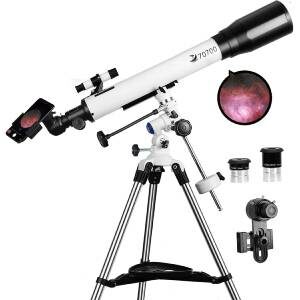
This refractor telescope features an equatorial mount and a 70mm aperture with a 700mm focal length. It comes with 10mm and 20mm Plossl eyepieces. Plossl eyepieces effectively reduce the halo effect and chromatic aberration, both of which can diminish your viewing overall experience. Plossl eyepieces also create a brighter image so you can get a clear picture of a variety of planets and other celestial objects.
To further enhance usability, the Solomark telescope has a built-in phone adapter to help you monitor and keep track of the objects you choose to view. Connecting your phone also allows you to take photos of your findings. This refractor telescope also comes with a stainless steel tripod and the entire device is easy to set up without using any tools.
If you are strongly considering this option, keep in mind that it does not come with a carry bag or case. Also, we think it could benefit from more detailed instructions. Finally, this may not be the best choice for you if you are a more advanced astronomy enthusiast.

A telescope is a scientific instrument used to magnify distant objects for up-close viewing. Telescopes can be used to look at objects on Earth but are most commonly used for viewing the night sky and outer space.
There are three different types of telescopes named for the way they enable magnification: reflecting, refracting, and compound. Understanding the difference between these types and what they are best used for is a good place to start when searching for the best telescopes.
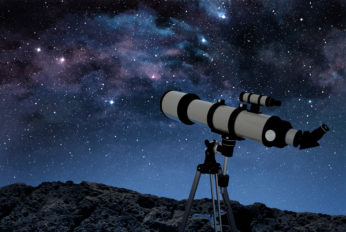
A refracting telescope uses a large fixed lens at the end of the telescope tube to collect and focus light for viewing through a second lens called the eyepiece. This type of telescope has at least two lenses but can include as many as four in the scope’s design.
Refracting telescopes are best for planetary and lunar observation. However, they are not recommended for deep sky viewing because they experience chromatic aberration which distorts the image and becomes more pronounced as the presence of light increases.
These telescopes are often smaller and more portable due to the fixed lens, even though they can be heavy. They require a sturdy, tall tripod for the best viewing experience.
A reflector telescope uses a concave mirror, known as the primary mirror, to gather and focus light which it then reflects down the tube, usually off of a second mirror, onto the eyepiece for observation.
There are many styles of reflector telescopes but the most popular, and possibly the best reflector telescope, is the Newtonian reflector invented by Sir Isaac Newton. It features an eyepiece on the side of the scope which allows you to have a shorter mount.
Reflecting telescopes are more fragile because the mirrors are not fixed in place inside the tube. They occasionally need collimation. Meaning, the lenses need to be adjusted for optimal alignment and cleaning. For this reason, reflecting telescopes are often considered the best home telescope, as they do not need to be moved.
Also, reflector telescopes are less expensive to make in large sizes and are the most common type of giant telescope housed in professional observatories around the world. Refracting telescopes are one of the best telescopes for home use as well if you have a large space and want to get serious about magnification. They are not affected by chromatic aberration. However, these telescopes are not recommended for viewing Earth objects.
A compound or catadioptric telescope combines the best parts of reflective and refractive telescopes – it uses both mirrors and lenses for viewing. The two most common types of combination telescopes are the Schmidt-Cassegrain telescope and the Maksutov-Cassegrain telescope.
Compound telescopes can also be integrated with technology for accurate and precise viewing. This makes them the ideal type of telescope for astrophotography, and the best telescope for viewing planets, deep sky, and for professionals as well.
Many telescope hobbyists use compound telescopes because they are more straightforward and you don’t have to spend quite as much to get decent quality images. They are also compact and do not require a large, elaborate mount.
Telescopes have a lot of moving parts and utilise a lot of specialised, highly technical terms that can be confusing for an amateur. After all, these are scientific instruments. That’s why we created this buyer’s guide to explain some telescope basics and outline a few of the most important traits to look for in a new telescope. This way, you can rest assured you will make a great choice when you’re ready.
Identifying the following traits in a telescope will help give you a basic understanding of what it is capable of and whether or not it could be a good choice for you specifically.
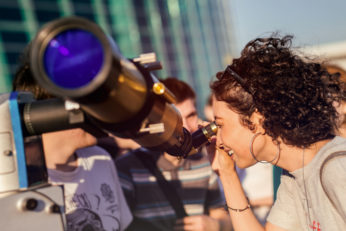
When it comes to understanding a telescope’s ability, the aperture is the primary trait to look for because it indicates how much light can be gathered to produce the magnified image. Greater aperture captures more light resulting in better image quality and the ability to see fainter heavenly bodies that are further away.
Aperture is represented by the diameter of the objective lens or primary mirror but is actually measured by the total surface area. Keep this in mind when comparing aperture sizes because it means that a 100mm lens can see 50% more detail than a 70mm lens. For the most part, telescopes with an aperture of less than 70mm are viewed as more of a toy than a scientific instrument. However, they aren’t always a bad choice when searching for budget telescopes or a way to view terrestrial objects.
Additionally, the greater the aperture the larger you can expect the overall size of the telescope to be. This is important if you live in an area with a lot of light pollution and plan on transporting the telescope for observational purposes.
Magnification is another indicator to look for in a new telescope. However, the indicated maximum magnification is only useable if the aperture can support the enlarged size. Generally speaking, a telescope can magnify double the aperture before it starts to compromise the image quality. So if a telescope’s aperture is 100mm, you should be able to magnify your observation point up to 200 times without it becoming blurry or pixelated.
The focal ratio of a telescope describes the field of view or how wide a portion of the night sky can be seen through the scope. The scope itself does not have as wide a peripheral view as your eyes. Hence, this can be important when trying to view a large section of the sky without moving the telescope’s focus.
To determine a telescope’s focal ratio, you’ll have to divide the aperture by the focal length to get what is referred to as the f/number. A high f/number indicates stronger magnification of a smaller arc of the sky, which is good for viewing smaller objects such as the rings of Saturn. A larger f/number is better for viewing a wider arc of sky and larger objects like nebulae.
Whether you are looking for the best telescope for beginners or for more serious astronomers, familiarity with the following components and terms may also prove beneficial for your search.
Focal length factors into a telescope’s magnification abilities. The focal length determines where the light collected by the telescope focuses inside the telescope tube. You may be familiar with the concept of focal length if you have seen how a magnifying glass can concentrate the sun’s rays in one small spot and start a fire. Telescopes magnify the image at the focal point through the lens on different eyepieces. This eliminates the need for a dial to increase magnification.
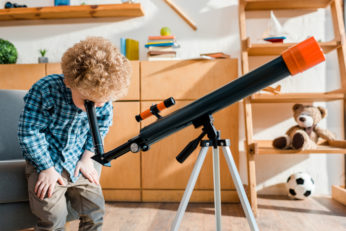
A mount is considered an essential part of a telescope. It holds the weight of the telescope while you look through the eyepiece and keeps the focal point in focus – ideally without any wobbling or shaking. There are two main types of telescope mounts: altitude-azimuth and equatorial.
An altitude-azimuth mount can move up and down, and left to right. It functions manually with a handle that allows precise adjustments. While altitude-azimuth mounts are a great user-friendly option for beginners, an equatorial mount is considered essential for professional users, astrophotographers, or anyone seeking deep space observation. An equatorial mount rotates on two axes, one of which follows the Earth’s rotation and can be programmed to do so automatically so you can observe a specific point for hours at a time.
A go-to driver is an excellent tool for accurately locating and targeting specific points in the sky. They’re not just for amateur telescope users either, although they are often found in the best telescopes for beginners. A finder can help you locate dimmer objects or even things invisible to the naked eye, when hooked up to the appropriate software. A go-to finder is essential for astrophotography or anyone who isn’t quite familiar with our solar system or galaxy.
Finders also help you to locate specific points in the sky. This device is often located on the side of the main scope and resembles a smaller telescope. Once you locate the desired spot in the finder, you can program the main telescope to mimic and focus on the same location automatically.
You have officially reached the end of our reviews for the top 10 telescopes. We hope you now have a better understanding of some of the scientific terms associated with this amazing instrument and how to choose the best telescope for your needs. Before you pick one of the options on our best-of list, let’s quickly review our Editor’s Choice.
We love the Celestron Travel Scope most of all because it consistently creates high-quality images and is a product of the most trusted brand when it comes to telescopes. It is also lightweight, compact, and quite portable with the provided backpack-style carrying case. It features a 70mm aperture, 400mm focal length, f/5.71 focal ratio, and comes with a 10mm and 20mm eyepieces. Plus, it has a 165x maximum theoretical magnification. A 5×24 finder scope, astronomy software, and free app download are also included for easy and precise galaxy navigation. No tools are required for setup with the aluminium alt-az tripod mount and the entire set only weighs 1.2 kg in total. Lastly, it is durable and comes with a two-year warranty.
Of course, the Celestron Travel Scope does have some room to grow and improve when it comes to the mount and the lenses but you can easily upgrade these components when and if you are ready to maximise the scope’s abilities.
Whether you are looking for the best telescopes for beginners or something for professional use, one of the choices on our list should accommodate you. Are you hoping for simple sky viewing like viewing stars? Or do you want a more advanced type of telescope that will illuminate planets, moons, nebulae, and more?
BESTSPY.CO.UK COPYRIGHT © 2020
BestSpy.co.uk is a participant in the Amazon EU Associates Programme, an affiliate advertising programme designed to provide a means for sites to earn advertising fees by advertising and linking to Amazon.co.uk.